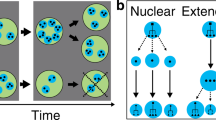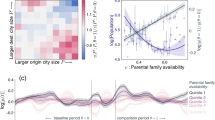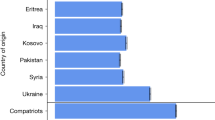Abstract
Understanding how refugees integrate into host societies has broad implications for researchers interested in intergroup conflict and for governments concerned with promoting social cohesion. Using detailed records tracking the movements and life histories of Finnish evacuees during World War II, we find that evacuees who intermarry are more likely to be educated, work in professional occupations, marry someone higher in social status and remain in the host community. Evacuees who intermarry before the war have fewer children, whereas those who marry into their host community after the war have more children. These results indicate that life-history and assimilation outcomes depend on key differences between pre-war environments—when migrants are living in their own communities—and post-war environments—when migrants are living in the host community. Overall, this suggests that integration involves a trade-off between reproduction and status such that evacuees who integrate gain social status, whereas those who maintain stronger bonds with their natal communities have higher fertility. We discuss these results within the framework of social capital, intergroup conflict and life-history theory and suggest how they can inform our understanding of evolutionary adaptations that affect tribalism.
This is a preview of subscription content, access via your institution
Access options
Access Nature and 54 other Nature Portfolio journals
Get Nature+, our best-value online-access subscription
$29.99 / 30 days
cancel any time
Subscribe to this journal
Receive 12 digital issues and online access to articles
$119.00 per year
only $9.92 per issue
Buy this article
- Purchase on Springer Link
- Instant access to full article PDF
Prices may be subject to local taxes which are calculated during checkout




Similar content being viewed by others
Code availability
The code used to produce these models, generate all results and produce all of the figures and tables in this paper and the Supplementary Information is available on GitHub, https://github.com/robertlynch66/Migrations-revisions-NHB, and is also included in Supplementary Software.
Data availability
The data that were used to generate these results and that support the findings of this study are available on GitHub: https://github.com/robertlynch66/Migrations-revisions-NHB.
References
Greenwood, P. J. Mating systems, philopatry and dispersal in birds and mammals. Anim. Behav. 28, 1140–1162 (1980).
Dobson, F. S. Competition for mates and predominant juvenile male dispersal in mammals. Anim. Behav. 30, 1183–1192 (1982).
Emlen, S. T. The evolution of helping. I. An ecological constraints model. Am. Nat. 119, 29–39 (1982).
West, S. A. et al. Cooperation and the scale of competition in humans. Curr. Biol. 16, 1103–1106 (2006).
Ortega, F. & Peri, G. The Causes and Effects of International Migrations: Evidence from OECD Countries 1980–2005 (National Bureau of Economic Research, 2009).
Glazer, N. & Moynihan, D. P. Beyond the melting pot. The Negroes. Puerto Ricans, Jews, Italians, and Irish of New York City. JAMA 186, 1027 (1963).
Hamilton, W. D. The genetical evolution of social behaviour. I. J. Theor. Biol. 7, 1–16 (1964).
Trivers, R. L. The evolution of reciprocal altruism. Q. Rev. Biol. 46, 35–57 (1971).
Greenwald, B. C. & Stiglitz, J. E. Externalities in economies with imperfect information and incomplete markets. Q. J. Econ. 101, 229–264 (1986).
Lawrence, P. R. & Lorsch, J. W. Differentiation and integration in complex organizations. Adm. Sci. Q. 12, 1–47 (1967).
Putnam, R. D., Leonardi, R. & Nanetti, R. Y. Making Democracy Work: Civic Traditions in Modern Italy (Princeton Univ. Press, Princeton, 1994).
Putnam, R. Bowling Alone: the Collapse and Revival of American Community (Simon and Schuster, New York, 2000).
Allport, G. W. The Nature of Prejudice (Addison, New York, 1954).
Pettigrew, T. F. & Tropp, L. R. A meta-analytic test of intergroup contact theory. J. Pers. Soc. Psychol. 90, 751–783 (2006).
Olson, M. Logic of Collective Action: Public Goods and the Theory of Groups (Harvard Economic Studies) (Harvard Univ. Press, Cambridge, 1965).
Alesina, A. & La Ferrara, E. Participation in heterogeneous communities. Q. J. Econ. 115, 847–904 (2000).
Friedberg, R. M. You can’t take it with you? Immigrant assimilation and the portability of human capital. J. Labor Econ. 18, 221–251 (2000).
Horvat, E. M., Weininger, E. B. & Lareau, A. From social ties to social capital: class differences in the relations between schools and parent networks. Am. Educ. Res. J. 40, 319–351 (2003).
Borjas, G. J. Assimilation, changes in cohort quality, and the earnings of immigrants. J. Labor Econ. 3, 463–489 (1985).
Quillian, L. Prejudice as a response to perceived group threat: population composition and anti-immigrant and racial prejudice in Europe. Am. Sociol. Rev. 60, 586–611 (1995).
Fennelly, K. & Federico, C. Rural residence as a determinant of attitudes toward US immigration policy. Int. Migr. 46, 151–190 (2008).
Marsden, P. V. Core discussion networks of Americans. Am. Sociol. Rev. 52, 122–131 (1987).
Bott, E. & Spillius, E. B. Family and Social Network: Roles, Norms and External Relationships in Ordinary Urban Families (Routledge, Oxon, 2014).
Bevelander, P. & Irastorza, N. Economic Integration of Intermarried Labour Migrants, Refugees and Family Migrants to Sweden: Premium Or Selection? (IZA, 2014).
Boustan, L. P., Fishback, P. V. & Kantor, S. The effect of internal migration on local labor markets: American cities during the Great Depression. J. Labor Econ. 28, 719–746 (2010).
Wilson, S., Bassiou, E., Denli, A., Dolan, L. C. & Watson, M. Traveling groups stick together: how collective directional movement influences social cohesion. Evol. Psychol. 16, 1474704918792134 (2018).
Silk, J. B., Alberts, S. C. & Altmann, J. Social bonds of female baboons enhance infant survival. Science 302, 1231–1234 (2003).
Choi, J.-K. & Bowles, S. The coevolution of parochial altruism and war. Science 318, 636–640 (2007).
Kulu, H. et al. Fertility by birth order among the descendants of immigrants in selected European countries. Popul. Dev. Rev. 43, 31–60 (2017).
Pailhé, A. The convergence of second-generation immigrants’ fertility patterns in France: the role of sociocultural distance between parents’ and host country. Demogr. Res. 36, 1361–1398 (2017).
Jejeebhoy, S. J. Women’s Education, Autonomy, and Reproductive Behaviour: Experience from Developing Countries (OUP, Oxford, 1995).
Coleman, D. A. Trends in fertility and intermarriage among immigrant populations in western Europe as measures of integration. J. Biosoc. Sci. 26, 107–136 (1994).
Goldscheider, C. & Uhlenberg, P. R. Minority group status and fertility. Am. J. Sociol. 74, 361–372 (1969).
Hacker, J. D. & Roberts, E. The impact of kin availability, parental religiosity, and nativity on fertility differentials in the late 19th-century United States. Demogr. Res. 37, 1049–1080 (2017).
Sosis, R. Why aren’t we all hutterites? Hum. Nat. 14, 91 (2003).
Wiley, N. F. The ethnic mobility trap and stratification theory. Soc. Probl. 15, 147–159 (1967).
Wilensky, H. L. & Edwards, H. The skidder: ideological adjustments of downward mobile workers. Am. Sociol. Rev. 24, 215–231 (1959).
Kramer, K. L. Cooperative breeding and its significance to the demographic success of humans. Annu. Rev. Anthropol. 39, 417–436 (2010).
Sear, R. & Coall, D. How much does family matter? Cooperative breeding and the demographic transition. Popul. Dev. Rev. 37, 81–112 (2011).
Portes, A. & Sensenbrenner, J. Embeddedness and immigration: notes on the social determinants of economic action. Am. J. Sociol. 98, 1320–1350 (1993).
Lavery, J. E. The History of Finland (Greenwood, Westport, 2006).
Haapala, P. & Toivo, R. M. Suomen Historian Kartasto (Karttakeskus, Helsinki, 2007).
Syrjänen, K., Honkola, T., Lehtinen, J., Leino, A. & Vesakoski, O. Applying population genetic approaches within languages: Finnish dialects as linguistic populations. Lang. Dyn. Change 6, 235–283 (2016).
Granovetter, M. The strength of weak ties: a network theory revisited. Sociol. Theory 1, 201–233 (1983).
Elwert, A. et al. Opposites attract—evidence of status exchange in ethnic intermarriages in Sweden. Lund Pap. Econ. His. 2016, 147 (2016).
Mäenpää, E. Homogamy in educational level and parental social class in Finland: a log-linear analysis. Eur. Sociol. Rev. 31, 253–267 (2014).
Chagnon, N. A., Lynch, R. F., Shenk, M. K., Hames, R. & Flinn, M. V. Cross-cousin marriage among the Yanomamö shows evidence of parent–offspring conflict and mate competition between brothers. Proc. Natl Acad. Sci. USA 114, E2590–E2607 (2017).
Chetty, R., Hendren, N., Kline, P. & Saez, E. Where is the land of opportunity? The geography of intergenerational mobility in the United States. Q. J. Econ. 129, 1553–1623 (2014).
Sarvimäki, M., Uusitalo, R. & Jantti, M. Long-Term Effects of Forced Migration (IZA, 2009).
Pagnini, D. L. & Morgan, S. P. Intermarriage and social distance among U.S. immigrants at the turn of the century. Am. J. Sociol. 96, 405–432 (1990).
Qian, Z. & Lichter, D. T. Social boundaries and marital assimilation: interpreting trends in racial and ethnic intermarriage. Am. Sociol. Rev. 72, 68–94 (2007).
Lichter, D. T., Qian, Z. & Tumin, D. Whom do immigrants marry? Emerging patterns of intermarriage and integration in the United States. Ann. Am. Acad. Pol. Soc. Sci. 662, 57–78 (2015).
Li, W., Airriess, C. A., Chen, A. C.-C., Leong, K. J. & Keith, V. Katrina and migration: evacuation and return by African Americans and Vietnamese Americans in an eastern New Orleans suburb. Prof. Geogr. 62, 103–118 (2010).
McCarthy, K. F., Peterson, D. J., Sastry, N. & Pollard, M. The Repopulation of New Orleans after Hurricane Katrina (Rand, 2006).
Shephard, B. The Long Road Home: the Aftermath of the Second World War (Vintage, London, 2010).
Communication from the Commission to the Council, the European Parliament, the European Economic and Social Committee and the Committee of the Regions: A Common Agenda for Integration—Framework for the Integration of Third-Country Nationals in the European Union COM/2005/0389 (European Commission, 2005).
How Germany is integrating its refugees. The Economist (16 September 2017); https://www.economist.com/news/europe/21728992-it-seems-be-managing-how-germany-integrating-its-refugees.
Lynch, R., Lynch, E., Loehr, J., Pettay, J. & Lummaa, V. Open Science Framework. How social class and occupations predict migration patterns and assimilation of forced migrants in wartime Finland (2017). Available at: https://osf.io/dvkfz/?view_only=12e5d392444e441d854132727a15e931.
Anonymous. Siirtokarjalaisten Tie (Nyky-Karjala, Turku, 1970).
Loehr, J., Lynch, R., Mappes, J., Salmi, T., Pettay, J., & Lummaa, V. (2017). Newly Digitized Database Reveals the Lives and Families of Forced Migrants from Finnish Karelia. Finnish Yearbook of Population Research, 52, 59-70. https://doi.org/10.23979/fypr.65212.
Hytönen, T. Sodanjälkeisen asutustoiminnan vaikutus suomen väestökehitykseen (2007). Master’s thesis, University of Jyväskylä.
Waris, H., Jyrkilä, V., Raitasuo, K. & Siipi, J. Siirtoväen Sopeutuminen Tutkimus Suomen Karjalaisen Siirtoväen Sosiaalisesta Sopeutumisesta (Helsingissä Otava, Helsinki, 1952).
McElreath, R. Statistical Rethinking: a Bayesian Course with Examples in R and Stan (Chapman and Hall/CRC, Boca Raton, 2015).
Gelman, A., Hill, J. & Yajima, M. Why we (usually) don’t have to worry about multiple comparisons. J. Res. Educ. Eff. 5, 189–211 (2012).
Acknowledgements
This research was supported by the Kone foundation. The funders had no role in study design, data collection and analysis, decision to publish or preparation of the manuscript. We thank J. Pettay for helping to translate much of the source data from Finnish to English, and J. Kallioniemi and T. Salmi for helping to extract the data from the original texts.
Author information
Authors and Affiliations
Contributions
R.L. wrote the first draft of the manuscript, conducted the statistical analysis and created the figures and tables. K.P. and K.M. helped design the statistical models. J.L. and V.L. planned the study and oversaw data collection. All authors helped to write and edit the manuscript.
Corresponding author
Ethics declarations
Competing interests
The authors declare no competing interests.
Additional information
Publisher’s note: Springer Nature remains neutral with regard to jurisdictional claims in published maps and institutional affiliations.
Supplementary information
Supplementary Information
Supplementary Methods, Supplementary Figures 1–5, Supplementary Tables 1–10, and Supplementary References
Rights and permissions
About this article
Cite this article
Lynch, R., Lummaa, V., Panchanathan, K. et al. Integration involves a trade-off between fertility and status for World War II evacuees. Nat Hum Behav 3, 337–345 (2019). https://doi.org/10.1038/s41562-019-0542-5
Received:
Accepted:
Published:
Issue Date:
DOI: https://doi.org/10.1038/s41562-019-0542-5
This article is cited by
-
Religiosity is associated with greater size, kin density, and geographic dispersal of women’s social networks in Bangladesh
Scientific Reports (2022)
-
Child volunteers in a women's paramilitary organization in World War II have accelerated reproductive schedules
Nature Communications (2020)
-
Migration, integration and reproduction
Nature Human Behaviour (2019)



